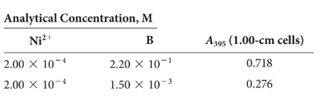
Mixing the chelating reagent B with Ni(II) forms the highly colored NiB22+, whose solutions obey Beer’s lawat 395 nm overa wide range. Provided the analytical concentration of the chelating reagent exceeds that of Ni(II) by a factor of 5 (or more), the cation exists, within the limits of observation, entirely in the form of the complex. Use the accompanying data to evaluate the formation constant Kf for the process

Trending nowThis is a popular solution!

Chapter 14 Solutions
Principles of Instrumental Analysis, 6th Edition
- A 3.03-g petroleum specimen was decomposed by wet ashing and subsequently diluted to 500 mL in a volumetric flask. Cobalt was determined by treating 25.00-mL aliquots of this diluted solution as follows: Assume that the Co(II)-ligand chelate obeys Beer’s law, and calculate the percentage of cobalt in the original sample.arrow_forwardThe thionitrosyl complex (nº-CsHs)Cr(CO)2(NS) has carbonyl bands at 2033 and 1962 cm-1, whereas the corresponding stretching vibrations for the NO complex, (n5-CsHs)Cr(CO)2(NO) are evident in the infrared spectrum at 2028 and 1955 cm1. On the basis of the differences in the infrared spectra, discuss which ligand (NO or NS) is the better TT acceptor in these complexes.arrow_forwardThe carbon-carbon bond length of coordinated ethylene in Ti(15-C5Me5)2(1²-C2H4) is 1.44 A, as determined by X-ray crystal structure analysis. Computational quantum mechanical modelling of the reactive intermediate [Ti(n5-Cp)₂Me(n²-C2H4)]* gives a carbon- carbon bond length of 1.34 Å for the coordinated ethylene ligand. Rationalise this difference in bond length. Sketch relevant molecular orbitals. (CsMes = pentamethylcyclopentadienyl)arrow_forward
- Calculate the equilibrium concentration of Ni²* in a solution with an analytical NİY2- concentration of 0.0100 M at pH 2.0 and pH 9.0. Kr of NIY2= 4.2 x 1018 HẠY Dissociation Constants: Ka1 =1.02 x 10² Ka2 =2.14 x 103 Ka3 =6.92 x 10-7 Ka4 =5.50 x 10-11arrow_forwardA transition metal ion, M, forms a coloured complex with a monodentate ligand L. Portions of a 0.05 mol dm-³ solution of M are mixed with portions of a solution containing 0.05 mol dm-³ of L so that the total volume of the resulting mixture is always 10 cm³. The colour intensity of the complex in each mixture is measured using a colorimeter. The graph of the results is 0 1 2 3 3 4 5 6 7 8 9 10 cm³ of M 10 9 8 7 6 5 4 3 2 1 0 - cm³ of L What is the formula of the complex? A ML B ML₂ C ML₂ с D D ML4 Colour intensity 7:2arrow_forwardA solution containing the complex formed between Bi(III) and thiourea has a molar absorptivity of 9.32 x 103 M-1 cm-1 at 470 nm. (a) Calculate the absorption of a 4.25x10-5 M solution of the complex at 470 nm in a 1-cm cell. (b) What is the molar concentration of the complex in a solution that has the calculated absorption in (a) when measured at 470 nm in a 2.50 cm cell?arrow_forward
- The stepwise formation constants for complexes of NH3 with [Cu(OH2)6]2+(aq) are log Kfl = 4.15, log Kf2 = 3.50, log Kf3 = 2.89, log Kf4 = 2.13, and log Kf5 = −0.52. Suggest a reason why Kf5 is so different.<arrow_forward(a) Write the electronic configuration of Ce3+ ion, and calculate the magnetic moment on the basis of ‘spin-only’ formula. [Atomic No. of Ce = 58] (b) Account for the following: (i) Thf enthalpies of atomisation of the transition metals are high. (ii) The lowest oxide of a transition metal is basic, the highest is amphoteric/ acidic. (iii) Cobalt (II) is stable in aqueous solution but in the presence of complexing agents, it is easily oxidised.arrow_forwardA method different from the method of Job to determine the coordination number of a complex is to measure the shift in polarographic half-wave potential Ex of a metal ion M²* to more negative values during complex formation as a function of the concentration of the added ligand L. A good example is complex formation between Cd²+ and NH3 to which the equation E-(E), = 0.0591 2 [NH3J/mol L-1 0 Ey/V log [NH3] {Ex-(Ex)s}/V n= applies, where (E₁), is the half-wave potential of the free Cd²+ metal ion (i.e. in the absence of the ligand NH3), and K and n, as before, are the formation constant and coordination number of the resulting complex Cd (NH3)², respectively. Use the tabled values below and the supplied graph paper to determine the coordination number and molecular formula of the complex by plotting E-(E), versus log[NH3] and calculating n from the slope of the straight line graph. formula: 0.0592 2 log K-n- -log[NH,] -0.752 3.14 -0.840 3.86 -0.856 4.75 -0.872 7.20 -0.904 8.86 -0.920arrow_forward
- The observed absorption band of the M2+ ion in the electronic spectrum of the hexaaqua complex is 7500 cm-1. How many kJ / mol is the crystal field cleavage of the tetraaqua complex of the same ion? (h = 6,626x10-34Js, c = 3x108ms-1)arrow_forward(a) The spectrochemical series of (a) Fe³+, (b) Co²+ and (c) Mn²+ ions follow the order: (b) Benzene is a field ligand relative to NH3 in the spectrochemical series. (c) For an octahedral Co³* complex with A. = 24,000 cm¹ and pairing energy per electron pair, P = 14,000 cm¹, the CFSE is m-¹. (enter final answer only). OR cmarrow_forwardPredict how altering the ligand donor/acceptor characteristics will affect Δo and how this is can be seen in the spectrochemical series.arrow_forward
 Principles of Instrumental AnalysisChemistryISBN:9781305577213Author:Douglas A. Skoog, F. James Holler, Stanley R. CrouchPublisher:Cengage Learning
Principles of Instrumental AnalysisChemistryISBN:9781305577213Author:Douglas A. Skoog, F. James Holler, Stanley R. CrouchPublisher:Cengage Learning


